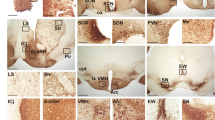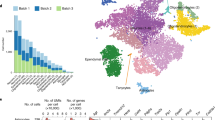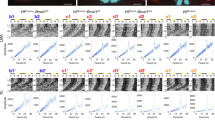Abstract
The suprachiasmatic nucleus (SCN) is the master circadian pacemaker in mammals, and one molecular regulator of circadian rhythms is the Clock gene. Here we studied the discharge patterns of SCN neurons isolated from Clock mutant mice. Long-term, multielectrode recordings showed that heterozygous Clock mutant neurons have lengthened periods and that homozygous Clock neurons are arrhythmic, paralleling the effects on locomotor activity in the animal. In addition, cells in dispersals expressed a wider range of periods and phase relationships than cells in explants. These results suggest that the Clock gene is required for circadian rhythmicity in individual SCN cells and that a mechanism within the SCN synchronizes neurons and restricts the range of expressed circadian periods.
This is a preview of subscription content, access via your institution
Access options
Subscribe to this journal
Receive 12 print issues and online access
$209.00 per year
only $17.42 per issue
Buy this article
- Purchase on SpringerLink
- Instant access to full article PDF
Prices may be subject to local taxes which are calculated during checkout





Similar content being viewed by others
References
Pittendrigh, C. S. Circadian rhythms and the circadian organization of living systems. Cold Spring Harbor Symp. Quant. Biol. 25, 159– 182 (1960).
Stephan, F. K. & Zucker, I. Circadian rhythms in drinking behavior and locomotor activity of rats are eliminated by hypothalamic lesions. Proc. Natl. Acad. Sci. USA 69, 1583– 1586 (1972).
Moore, R. Y. & Eichler, V. B. Loss of a circadian adrenal corticosterone rhythm following suprachiasmatic lesions in rat. Brain Res. 42, 201–206 (1972).
Ralph, M. R., Foster, R. G., Davis, F. C. & Menaker, M. Transplanted suprachiasmatic nucleus determines circadian period. Science 247, 975–978 ( 1990).
Welsh, D. K., Logothetis, D. E., Meister, M. & Reppert, S. M. Individual neurons dissociated from rat suprachiasmatic nucleus express independently phased circadian firing rhythms. Neuron 14, 697–706 (1995).
Shinohara, K., Honma, S., Katsuno, Y., Abe, H. & Honma, K. Two distinct oscillators in the rat suprachiasmatic nucleus in vitro. Proc. Natl. Acad. Sci. USA 92, 7396– 7400 (1995).
Konopka, R. J. & Benzer, S. Clock mutants of Drosophila melanogaster . Proc. Natl. Acad. Sci. USA 68, 2112 –2116 (1971).
Dunlap, J. C. Circadian rhythms: an end in the beginning. Science 280, 1548–1549 (1998).
Price, J. L., Dembinska, M. E., Young, M. W. & Rosbash, M. Suppression of PERIOD protein abundance and circadian cycling by the Drosophila clock mutation timeless. EMBO J. 14, 4044–4049 (1995).
Gekakis, N. et al. Isolation of timeless by PER protein interaction: Defective interaction between timeless protein and long-period mutant PERL. Science 270, 811– 815 (1995).
Darlington, T. K. et al. Closing the circadian loop—CLOCK-induced transcription of its own inhibitors, PER and TIM. Science 280, 1599–1603 (1998).
Allada, R., White, N. E., So, W. V., Hall, J. C. & Rosbash, M. A mutant Drosophila homolog of mammalian Clock disrupts circadian rhythms and transcription of period and timeless. Cell 93, 791– 804 (1998).
Rutila, J. E. et al. CYCLE is a second bHLH-PAS clock protein essential for circadian rhythmicity and transcription of Drosophila period and timeless . Cell 93, 805–814 (1998).
Gekakis, N. et al. Role of the CLOCK protein in the mammalian circadian mechanism. Science 280, 1564–1569 (1998).
Kloss, B. et al. The Drosophila clock gene double-time encodes a protein closely related to human casein kinase Iε. Cell 94, 97–107 ( 1998).
Price, J. L. et al. Double-time is a novel Drosophila clock gene that regulates PERIOD protein accumulation. Cell 94 , 83–95 (1998).
Vitaterna, M. H. et al. Mutagenesis and mapping of a mouse gene, Clock, essential for circadian behavior. Science 264, 719 –725 (1994).
King, D. P. et al. Positional cloning of the mouse circadian clock gene. Cell 89, 641–653 ( 1997).
Antoch, M. P. et al. Functional identification of the mouse circadian Clock gene by transgenic BAC rescue. Cell 89, 655– 667 (1997).
Hogenesch, J. B., Gu, Y. Z., Jain, S. J. & Bradfield, C. A. The basic helix-loop-helix-PAS orphan MOP3 forms transcriptionally active complexes with circadian and hypoxia factors. Proc. Natl. Acad. Sci. USA 95, 5474–5479 ( 1998).
Liu, C., Weaver, D. R., Strogatz, S. H. & Reppert, S. M. Cellular construction of a circadian clock: period determination in the suprachiasmatic nuclei. Cell 91, 855–860 (1997).
Herzog, E. D., Geusz, M. E., Khalsa, S. B., Straume, M. & Block, G. D. Circadian rhythms in mouse suprachiasmatic nucleus explants on multimicroelectrode plates. Brain Res. 757, 285–290 (1997).
van den Pol, A. N. & Dudek, F. E. Cellular communication in the circadian clock, the suprachiasmatic nucleus. Neuroscience 56, 793–811 ( 1993).
Reppert, S. M. & Schwartz, W. J. The suprachiasmatic nuclei of the fetal rat: characterization of a functional circadian clock using 14C-labeled deoxyglucose. J. Neurosci. 4, 1677–1682 (1984).
Reppert, S. M. & Schwartz, W. J. Maternal coordination of the fetal biological clock in utero. Science 220 , 969–971 (1983).
Schwartz, W. J., Gross, R. A. & Morton, M. T. The suprachiasmatic nuclei contain a tetrodotoxin-resistant circadian pacemaker. Proc. Natl. Acad. Sci. USA 84, 1694–1698 (1987).
Schwartz, W. J. Further evaluation of the tetrodotoxin-resistant circadian pacemaker in the suprachiasmatic nuclei. J. Biol. Rhythms 6, 149–158 (1991).
Block, G. D., McMahon, D. G., Wallace, S. F. & Friesen, W. O. Cellular analysis of the Bulla ocular circadian pacemaker system: I. A model for retinal organization. J. Comp. Physiol. A 155, 365–378 (1984).
Jacklet, J. W. & Colquhoun, W. Ultrastructure of photoreceptors and circadian pacemaker neurons in the eye of a gastropod, Bulla. J. Neurocytol. 12, 673– 696 (1983).
Prosser, R. A., Edgar, D. M., Heller, H. C. & Miller, J. D. A possible glial role in the mammalian circadian clock. Brain Res. 643, 296–301 ( 1994).
Jiang, Z. G., Yang, Y. Q. & Allen, C. N. Tracer and electrical coupling of rat suprachiasmatic nucleus neurons. Neuroscience 77, 1059– 1066 (1997).
LeSauter, J., Lehman, M. N. & Silver, R. Restoration of circadian rhythmicity by transplants of SCN micropunches. J. Biol. Rhythms 11, 163–171 (1996).
Murakami, N. et al. Long-term cultured neurons from rat suprachiasmatic nucleus retain the capacity for circadian oscillation of vasopressin release. Brain Res. 545, 347–350 (1991).
Ding, J. M. et al. Resetting the biological clock: mediation of nocturnal circadian shifts by glutamate and NO. Science 266, 1713–1717 (1994).
Watanabe, A., Hamada, T., Shibata, S. & Watanabe, S. Effects of nitric oxide synthase inhibitors on N-methyl-D-aspartate-induced phase delay of circadian rhythm of neuronal activity in the rat suprachiasmatic nucleus in vitro . Brain Res. 646, 161– 164 (1994).
Nieoullon, A., Cheramy, A. & Glowinski, J. Release of dopamine in vivo from cat substantia nigra. Nature 266, 375–377 (1977).
Balsalobre, A., Damiola, F. & Schibler, U. A serum shock induces circadian gene expression in mammalian tissue culture cells. Cell 93, 929– 937 (1998).
Yamazaki, S., Kerbeshian, M. C., Hocker, C. G., Block, G. D. & Menaker, M. Rhythmic properties of the hamster suprachiasmatic nucleus in vivo. J. Neurosci. (in press).
Loudon, A. S. et al. Ultradian endocrine rhythms are altered by a circadian mutation in the Syrian hamster. Endocrinology 135, 712–718 (1994).
Gross, G. W., Williams, A. N. & Lucas, J. H. Recording of spontaneous activity with photoetched microelectrode surfaces from mouse spinal neurons in culture. J. Neurosci. Methods 5, 13–22 (1982).
Gross, G. W. & Schwalm, F. U. A closed flow chamber for long-term multichannel recording and optical monitoring. J. Neurosci. Methods 52, 73–85 ( 1994).
Meister, M., Pine, J. & Baylor, D. A. Multi-neuronal signals from the retina: acquisition and analysis. J. Neurosci. Methods 51, 95 –106 (1994).
Simon, J. Resampling: The New Statistics (Resampling Stats, Arlington, Virgina, 1995).
Acknowledgements
We wish to thank David King for guidance in allele-specific genotyping, Martha Vitaterna and Sharon Low-Zeddies for providing mice, Naomi Ihara, Michael Menaker and Shin Yamazaki for assistance with behavioral assays, and Christine Harrer, Li Miao and John Williamson for technical assistance. We are also grateful to Martin Straume for statistical advice and to Tom Breeden for programming the data acquisition system. This work was supported by the NSF Center for Biological Timing and a NIH Endocrine Training grant to E.D.H. J.S.T. is an Investigator in the Howard Hughes Medical Institute.
Author information
Authors and Affiliations
Corresponding author
Rights and permissions
About this article
Cite this article
Herzog, E., Takahashi, J. & Block, G. Clock controls circadian period in isolated suprachiasmatic nucleus neurons. Nat Neurosci 1, 708–713 (1998). https://doi.org/10.1038/3708
Received:
Accepted:
Issue Date:
DOI: https://doi.org/10.1038/3708
This article is cited by
-
On the origin and evolution of the dual oscillator model underlying the photoperiodic clockwork in the suprachiasmatic nucleus
Journal of Comparative Physiology A (2023)
-
The trilateral interactions between mammalian target of rapamycin (mTOR) signaling, the circadian clock, and psychiatric disorders: an emerging model
Translational Psychiatry (2022)
-
T cell reactivity to regulatory factor X4 in type 1 narcolepsy
Scientific Reports (2021)
-
Circadian neurons in the paraventricular nucleus entrain and sustain daily rhythms in glucocorticoids
Nature Communications (2021)
-
Non-coding cis-element of Period2 is essential for maintaining organismal circadian behaviour and body temperature rhythmicity
Nature Communications (2019)



